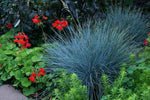
Festuca Intense Blue Grass
Blue Grass - Ornamental Grass Plants
£9.99
Unit price perCan grow up to 30 cm in the right conditions.
9 cm
Flowering: summer
- Festuca Bluegrass is easy to maintain, requiring minimal watering and mowing, making it a hassle-free solution for busy homeowners. Its slow growth rate means that it stays looking great for longer, with less need for frequent trimming. With a high tolerance to wear and tear, it's also an excellent choice for families and pet owners.
- With its fine texture and stunning blue-green hue, Festuca Bluegrass will transform your garden into a picture-perfect oasis. This hard-wearing grass is ideal for the UK climate, thriving in both sunny and shady areas, and is also resistant to drought and disease.
- Strong Plants In 9 cm Pots - Ready To Be Planted.
Full sun
Minimal watering
Grow in poor to moderately fertile, well-drained soil in full sun. Divide every few years in late winter or early spring to maintain vigour.
Standard Delivery (2-4 working days)
£2.99 on orders under £30
FREE on orders over £30
*Mainland UK only
Next Working Day Delivery
£4.99 on orders under £70
FREE on orders over £70
Order by 1pm Mon-Fri
Northern Ireland & Islands Delivery (2-5 working days)
£4.99 for all orders
Discover more in
-
ALPINE & ROCKERY PLANTS
CLIMATE RESILIENT PLANTS
DOG FRIENDLY PLANTS
FULL PRICE (INCL. CHRISTMAS TREES)
LOW MAINTENANCE GARDEN PLANTS
ORNAMENTAL GRASSES
OUTDOOR EVERGREEN PLANTS
OUTDOOR PLANTS
WATER CONSCIOUS GARDEN

There are several reasons why you might consider buying a Festuca Blue Grass for your garden
Aesthetic appeal
Low maintenance
Erosion control
Wildlife habitat
Air purification

Fescue Blue Grass Facts




